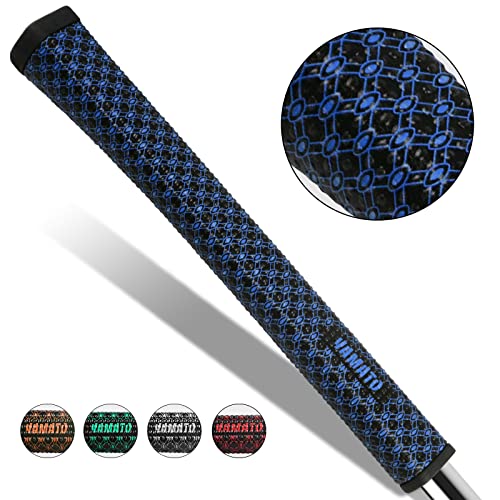Golf Club Grips: A Comprehensive Guide To Choosing The Right One

- 1. Golf Club Grips: A Comprehensive Guide To Choosing The Right One
- 1.1. What Are Golf Club Grips?
- 1.2. The Importance of Golf Club Grips
- 1.3. Choosing the Right Grip
- 1.3.1. Golf Grip Size (Outer Diameter)
- 1.3.2. Golf Grip Core Size (Inner Diameter)
- 1.3.3. Golf Grip Style/Material
- 1.3.4. Golf Grip Feel
- 1.3.5. Golf Grip Weather Management
- 1.4. When To Change Golf Grips
- 1.5. Maintaining Golf Club Grips
- 1.6. Conclusion
Golf club grips might seem like a small detail in the game, but they play a significant role in a golfer’s performance. Often overlooked, these seemingly humble components are essential for a golfer's comfort, control, and ultimately, their swing. From material to size and texture, each aspect of a golf club grip can greatly impact a player's game.
What Are Golf Club Grips?
Golf club grips are the rubber or synthetic coverings on the handles of golf clubs. They serve as the primary point of contact between the golfer and the club, providing a comfortable and secure grip. Grips play a crucial role in a golfer's ability to control the club and execute shots effectively.
The Importance of Golf Club Grips
Golf grips are the only point of contact between the player and the club, making their significance paramount. A proper grip can enhance a golfer's ability to control the clubface, allowing for more consistent shots. Conversely, worn-out or poorly fitting grips can lead to slipping during swings, causing mishits and affecting accuracy.
Choosing the Right Grip
When in the market for new golf grips, having a grasp on what to seek and how to pinpoint the perfect grip is crucial. Below are essential insights outlining key aspects to consider when selecting golf grips:
Golf Grip Size (Outer Diameter)
Golf grips are available in six distinct "sizes" denoting their outer diameter: Standard, Midsize, Oversize/Jumbo, Undersize, and Junior. While different manufacturers may slightly vary in their sizing definitions, a Standard grip typically measures around 1" in diameter. Midsize and Oversize/Jumbo grips exhibit more variability, generally ranging between +1/8" to +3/8" larger in diameter. A conventional method of measuring involves assessing the diameter 5cm below the grip's butt end, often aligning with the upper hand wrist. Conversely, Undersize and Junior grips fall below the 1" mark, sometimes nearing 0.8" or even less. Given the diversity in hand and finger sizes, it's prudent to test holding an installed grip before committing to resizing your entire set of clubs.
Golf Grip Core Size (Inner Diameter)
Distinct from the outer diameter, another critical measurement is the golf grip core size or inner diameter. The majority of golf grips feature an inside diameter of either 0.600" or 0.580", mirroring the outer diameter of most golf shafts. Typically, club-builders aim to match the core size of the grip with the shaft's outer diameter. At times, they might opt for a 0.580" core size grip on a 0.600" butt diameter shaft, slightly increasing the grip's outer diameter. Additionally, there are grips available with smaller diameters (usually for undersize or junior shafts ranging from 0.500" to 0.560") or notably larger ones (for bubble shafts, approximately 0.800" or more).
Golf Grip Style/Material
Golf grips encompass a diverse array of styles, typically falling into categories such as Velvet, Composite, Wrap, Cord, and Hybrid (Cord + Rubber). Velvet grips offer subtle texture and traction, providing control without compromising feel. On the other hand, the Composite grip, boasts a tacky and smooth surface, featuring visually enhancing patterns and a non-slip grip.
The Wrap style grip mimics the appearance of a one-piece construction through its wrap design. Cord grips, interweaving cord fabric through the surface, deliver enhanced traction and firmness, ensuring valuable feedback. In contrast, the Hybrid style represents a modern approach, combining both cord and rubber.
Golf Grip Feel
When it comes to golf grips, they generally fall into three distinct "feel" categories: Soft, Medium, and Firm. The feel of a grip is a highly subjective preference. Firm grips typically offer more feedback upon impact, providing a clearer sensation to the hands. In contrast, soft grips absorb some impact, delivering a more cushioned and comfortable feel. Individuals dealing with arthritis or experiencing hand discomfort often find better playability with softer (and/or larger) grips. For those inclined towards softer grips, selecting a grip with a stable core, minimizing torque to prevent twisting during swings, is crucial. On the other hand, cord and velvet-style grips often cater to those seeking a firmer feel, offering sharper feedback.
Golf Grip Weather Management
The longevity of golf grips is limited, prompting consideration for weather conditions. In regions with wet or high moisture levels, choosing grips equipped with superior moisture management becomes essential. Grips designed with cord styles or using composite materials excel in wet weather play, providing durability and a non-slip performance, ensuring prolonged usability even in challenging weather conditions.
When To Change Golf Grips
How can you tell it's time for a golf grip replacement? While sweat, dirt, and wear from regular use are obvious indicators, some subtler signs suggest it might be time for a change.
- Increased Grip Pressure: If you find yourself needing to grip the club tightly to maintain control during impact, it could signal grip deterioration.
- Deteriorated Texture: The grip's texture may degrade over time, particularly in humid climates, leading to a slippery feel that compromises your hold on the club.
- Trail Hand Overinvolvement: An excess role of the trail hand (right for right-handed golfers) in your swing could indicate the need for a grip with less or no taper, potentially rectifying this swing flaw.
- Lack of Control: If you struggle to maintain control through impact, especially without a golf glove, resulting in hooks or slices, it might be due to an ineffective grip.
- Loss of Tackiness: When the grip loses its tackiness, reducing the overall grip and feel, it's a clear sign that it needs replacement.
Maintaining Golf Club Grips
Maintaining grips is essential for longevity and optimal performance. Regularly cleaning grips with mild soap and water helps remove dirt and oils that can accumulate over time, maintaining their traction and feel. Additionally, replacing grips when they show signs of wear—such as cracks, smooth surfaces, or loss of tackiness—is crucial for consistent performance.
Conclusion
In the realm of golf equipment, grips often don't receive the attention they deserve. However, they significantly influence a player's ability to control the club and, consequently, their game. The right grip choice, considering material, size, texture, and maintenance, can make a substantial difference in a golfer's comfort, confidence, and performance on the course.










